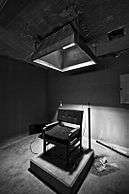Tennessee State Prison
|
Tennessee State Penitentiary Main Entrance, circa 2006 | |
| Location | Nashville, Tennessee |
|---|---|
| Coordinates | 36°10′38″N 86°51′55″W / 36.1772°N 86.8654°WCoordinates: 36°10′38″N 86°51′55″W / 36.1772°N 86.8654°W |
| Status | Closed: 1992 |
| Security class | High/Medium security |
| Capacity | ~1,400 |
| Opened | 1898 |
Tennessee State Prison is a former correctional facility located near downtown Nashville, Tennessee. Opened in 1898, the prison has been closed since 1992.[1] It has been the location for the films Nashville, Marie, Ernest Goes to Jail, Against the Wall, The Green Mile, The Last Castle,[2] two of Eric Church's music videos "Lightning" and "Homeboy", and Pillar's "Bring Me Down" music video. Most recently VH1's Celebrity Paranormal Project filmed there for the third episode of the series (titled "The Warden") as well as the last episode of the first season (titled "Dead Man Walking"). The prison was referred to as "The Walls Maximum Security Prison" in both episodes to protect the location's privacy.
History
The proposed prison design called for the construction of a fortress-like structure patterned after the penitentiary at Auburn, New York, made famous for the lockstep marching, striped prisoner uniforms, nighttime solitary confinement, and daytime congregate work under strictly enforced silence. The new Tennessee prison contained 800 small cells, each designed to house a single inmate. In addition, an administration building and other smaller buildings for offices, warehouses, and factories were built within the twenty-foot (6.15m)high, three-foot (1 m) thick rock walls. The plan also provided for a working farm outside the walls and mandated a separate system for younger offenders to isolate them from older, hardened criminals.
The prison was built by Enoch Guy Elliott who was married to Lady Ida Beasley Elliott (Missionary to Burma). Gov. Turney made Enoch Guy Elliott the Chief Warden of the old prison and then during the building of the second prison, Enoch used primarily prison labor to build the new prison.
Construction costs for this second Tennessee State Penitentiary exceeded US$500,000 (US$12.3 million in 2007 dollars), not including the price of the land. The prison's 800 cells opened to receive prisoners on February 12, 1898, and that day admitted 1,403 prisoners, creating immediate overcrowding. To a greater or lesser extent, overcrowding persisted throughout the next century. The original Tennessee State Penitentiary on Church Street was demolished later that year, and salvageable materials were used in the construction of outbuildings at the new facility, creating a physical link from 1830 to the present.
Every convict was expected to defray a portion of the cost of incarceration by performing physical labor. Within two years, inmates worked up to sixteen hours per day for meager rations and unheated, unventilated sleeping quarters. The State also contracted with private companies to operate factories inside the prison walls using convict labor.
The Tennessee State Penitentiary had its share of problems. In 1902, seventeen prisoners blew out the end of one wing of the prison, killing one inmate and allowing the escape of two others who were never recaptured. Later, a group of inmates seized control of the segregated white wing and held it for eighteen hours before surrendering. In 1907 several convicts commandeered a switch engine and drove it through a prison gate. In 1938 inmates staged a mass escape. Several serious fires ignited at the penitentiary, including one that destroyed the main dining room. Riots occurred in 1975 and 1985.
In 1989 the Tennessee Department of Correction opened a new penitentiary, the Riverbend Maximum Security Institution at Nashville. The old Tennessee State Penitentiary closed in June 1992. As part of the settlement in a class action suit, Grubbs v. Bradley (1983), the Federal Court issued a permanent injunction prohibiting the Tennessee Department of Correction from ever again housing inmates at the Tennessee State Prison.
Gallery
 Abandoned Cell Block
Abandoned Cell Block What Remains of the Electric Chair Chamber on Death Row
What Remains of the Electric Chair Chamber on Death Row Typical Cell Facilities
Typical Cell Facilities
References
- ↑ Tennessee Department of Corrections. "Tennessee State Penitentiary". Retrieved 2009-12-22.
- ↑ "Free Locations". Tennessee Film, Entertainment & Music Commission. Retrieved 2009-12-23.
External links
- IMDb Entry
- Tennessee State Prison at Abandoned
